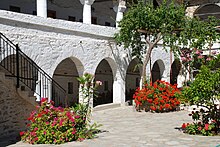Paleo Trikeri
| Paleo Trikeri | ||
|---|---|---|
| Waters | Aegean | |
| Geographical location | 39 ° 10 ′ N , 23 ° 5 ′ E | |
|
|
||
| length | 3.15 km | |
| width | 1.66 km | |
| surface | approx. 2.0 km² | |
| Highest elevation | 105 m | |
| Residents | 86 | |
| main place | Aghios Ioanis | |
Paleo Trikeri ( Old Trikeri , Greek Παλαιό Τρίκερι ( n. Sg. ), Pronunciation : [ palɛˈɔ ˈtrikʲeri ]; also Trikeri Τρικέρι) is a small island in the Pagasitic Gulf at the foot of the Pelion . It belongs to the territory of the municipality of Notio Pilio in the Greek region of Thessaly .
It is said that the Argo , the ship of the Argonauts, landed there in order to be pledged again.
Today Paleo Trikeri, unlike the village of Trikeri on the mainland, is hardly inhabited anymore. The 2001 census still shows 86 registered residents, around 20 residents still live there in winter. The island has a long history, which was particularly significant in Christian times: The church of Aghia Sofia, after which a bay is still called today, has since fallen into the sea, but there are four other churches on the island that still exist today .
According to legend, a miraculous icon was once found on the island. A church and later a monastery were supposedly built for this. The icon still exists. Every September 9th, people from all over the Sporades come together to worship the icon and celebrate a common festival.
Paleo Trikeri is a sacred place for the Orthodox Church of Greece . There is the Church of Panaghia (Mother of God) and the Monastery of Panaghia Evangelistria , which, although never accommodated a monk, served as a home for the olive pickers during the Ottoman Empire .
After the civil war in Greece , Paleo Trikeri was a concentration camp for women for several years. They were detained here because they or family members were active on the left popular front . About 5000 women and children were held captive on the island in appalling conditions. Their traces can still be found today in the form of bakery and bath houses. These women were later relocated because they allegedly had too much contact (illuminated signs) with like-minded people in Pelion.
From 1957 to 1969 the monastery was leased to the Austrian Alfons Hochhauser . He ran a simple guesthouse there together with his Greek wife Chariklia, which was mostly visited by guests from Germany, Austria and England. The writer Ernst Kreuder dealt with his stay on the island in the story "Spur unterm Wasser".
Paleo Trikeri is car-free, there are no roads. The garbage collection is also done with mules .
To the northwest of the island are three uninhabited small islets, Pythou, Strongyli and Psathou.
Paleo Trikeri is now an olive island with little tourism. At least in summer there is a ferry between Alogoporos on the mainland and Agios Ioannis on the island. There are two taverns at the port, which are mainly frequented by fishermen and sailors.

